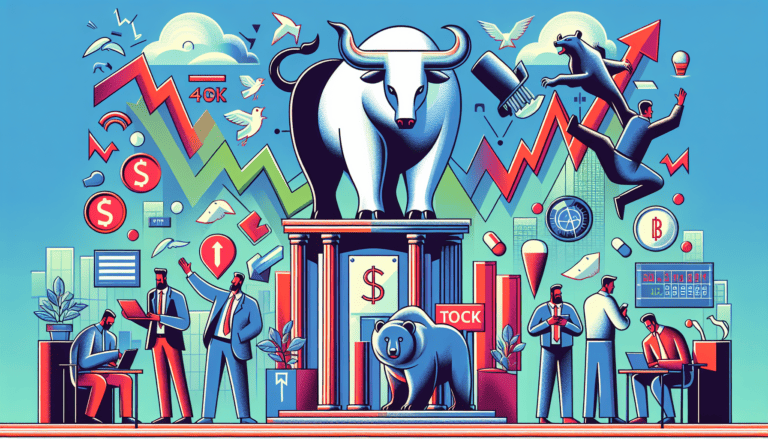Cracking the Code: Decoding Stock Market Bubbles and Crashes for Beginners

Understanding Financial Markets
In this section, we’ll lay the foundation for beginners to comprehend the dynamics of financial markets, with a focus on stock markets and exchanges. This background is essential for recognizing patterns that lead to ‘stock market bubbles and crashes’.
Basics of Stock Markets
Stock markets are platforms where buyers and sellers come together to trade stocks, which are essentially shares of ownership in publicly traded companies. These transactions provide opportunities for individuals to grow their wealth through capital appreciation and dividends. Stocks are a key component for investors to diversify their investment portfolios, spreading risk across various sectors and potentially enhancing returns (Forbes).
The stock market is a reflection of the economy and plays a significant role in helping companies raise capital. By selling shares of their ownership, companies can fund operations, invest in growth, and create shareholder value (Forbes). For a deeper dive into how trading works, explore the mechanics of stock trading.
Role of Stock Exchanges
Stock exchanges, such as the New York Stock Exchange (NYSE) and NASDAQ, are the infrastructures that facilitate the buying and selling of stocks. They are crucial for maintaining fair and transparent trading, ensuring that stock prices reflect the true value of the underlying companies (Forbes).
These exchanges serve as a centralized marketplace for investors, providing liquidity and enabling price discovery for securities. They also play an integral role in the economy by allowing companies to access funding from the public and by enabling investors to participate in the growth of these businesses (Investopedia).
Investor confidence in the market is fostered by the stock exchanges’ commitment to enforcing regulations and promoting transparent trading. This environment attracts both domestic and international investors, which is essential for a dynamic and healthy market (Forbes).
To understand the role of stock exchanges in facilitating initial public offerings (IPOs), the importance of market capitalization, and the functioning of electronic trading, visit our detailed guides on these topics. Additionally, for those interested in the global perspective, our article on major global stock exchanges provides an overview of how international markets operate.
Anatomy of Stock Market Bubbles
Stock market bubbles are phenomena characterized by a swift escalation in stock prices well beyond their intrinsic values, predominantly driven by investor enthusiasm and speculative trading. Understanding the stages of stock market bubbles is crucial for beginner investors to recognize unsustainable market trends. Here’s an overview of the four critical phases of a stock market bubble.
The Stealth Phase
The inception of a stock market bubble typically begins with the stealth phase. During this initial stage, stock prices start to increase modestly, and the uptrend goes largely unnoticed by the mainstream investment community. Astute investors, often with more information or insight, begin to accumulate stocks based on fundamental analysis or early recognition of potential. This phase is marked by low volume and seemingly insignificant price movements, setting the stage for what may later become a bubble. Investopedia provides a detailed insight into this preliminary phase.
The Awareness Phase
As the stealth phase matures, the awareness phase begins. This stage is characterized by more investors recognizing the upward trajectory of stock prices and starting to invest with the expectation of substantial gains. Media coverage often increases during this phase, adding to the growing excitement. The rising investor interest results in higher trading volumes and more significant price increases. It is during the awareness phase that the momentum begins to build, and the narrative around certain stocks or sectors starts to strengthen, capturing the attention of a broader investor base.
The Mania Phase
The mania phase is where the speculative fervor reaches its zenith. During this period, the fear of missing out (FOMO) on lucrative returns grips the market, and more investors rush to buy stocks, often disregarding valuation metrics. Prices skyrocket as speculation overtakes rational investment decisions. In this stage, the market may witness a surge in initial public offerings (IPOs) and an increase in leveraged investing, as individuals and institutions alike seek to capitalize on the expanding bubble. The mania phase is often where the highest price increases occur, but it is also the most dangerous time to invest, as the risk of a downturn grows.
The Blow-off Phase
The blow-off phase signifies the culmination of the bubble, where the price escalation becomes unsustainable. The realization that stock prices are not supported by underlying fundamentals begins to dawn on investors, leading to a rapid sell-off. This reversal of sentiment can be triggered by a variety of factors, including changes in economic indicators, shifts in investor psychology, or external shocks to the financial system. The result is a sharp decline in stock prices, often leading to significant financial losses for those who entered the market in the later stages of the bubble. The blow-off phase is a stark reminder of the importance of risk management strategies in stock investing.
The cyclical nature of stock market bubbles and crashes underscores the necessity for investors, especially beginners, to be well-informed and cautious. Recognizing the stages of a bubble can help investors make more informed decisions and potentially avoid the pitfalls of market excesses. For a deeper understanding of stock market dynamics, one can explore topics such as stock market indices explained and the mechanics of stock trading.
Historical Market Crashes Explored
Throughout history, the financial markets have experienced a number of significant downturns. These events have not only affected investors but also had wide-ranging implications for economies worldwide. In this section, we’ll look at some of the most notable market crashes, exploring their causes and impacts.
The Panic of 1907
The Panic of 1907 was a key moment in the history of the financial markets, marked by a severe monetary contraction and numerous bank runs. Triggered by the bankruptcy of the Knickerbocker Trust Company, the panic saw the Dow Jones Industrial Average (DJIA) lose 50% of its value. This event underscored the vulnerabilities within the banking system and ultimately led to the creation of the Federal Reserve System. (Investopedia)
Black Tuesday 1929
The infamous Wall Street Crash of 1929, also known as Black Tuesday, is one of the most devastating crashes in stock market history. The DJIA plummeted 12% in a single day, wiping out billions of dollars of wealth and marking the onset of the Great Depression. This era affected not just stock markets but also employment, production, and the livelihoods of many worldwide. (Investopedia)
The Dotcom Bubble Burst
At the turn of the millennium, the bursting of the Dotcom Bubble became a stark reminder of the dangers of speculative investing. The NASDAQ Composite Index, heavily laden with technology stocks, saw a dramatic 78% decline in value over two years. This period saw many internet-based companies’ stock values collapse, subsequently leading to a recession in the early 2000s. (Investopedia)
The 2008 Financial Crisis
The 2008 Global Financial Crisis, triggered by the collapse of Lehman Brothers, led to a severe worldwide economic crisis. The DJIA saw a decline of more than 50%, with ripple effects felt across global markets. The crisis, rooted in the subprime mortgage market, resulted in massive foreclosures and job losses, igniting discussions about financial regulation and oversight. (Investopedia)
The 2020 COVID-19 Crash
The COVID-19 pandemic of 2020 led to one of the sharpest market downturns in history. Major stock indices, including the DJIA, saw precipitous drops, with the index shedding over 10,000 points in just a few weeks. The pandemic-induced crash affected all sectors and led to unprecedented volatility and market uncertainty. (Investopedia)
Each of these historical market crashes offers valuable lessons for navigating financial markets. For beginner investors, understanding these events can provide insights into the cyclical nature of markets, the importance of risk management, and the need for regulatory safeguards. As history has shown, stock market bubbles and crashes are an integral part of financial markets, shaping not only investment strategies but also economic policies.
The Impact of Bubbles and Crashes
The aftermath of stock market bubbles and crashes can be far-reaching, affecting not only individual investors but also the broader economy. This section explores these impacts in detail.
Effects on Investors
When a stock market bubble bursts, the rapid deflation often leads to significant monetary losses for investors. According to Investopedia, this can result in financial instability for individuals and institutions alike. The decline in stock prices can quickly erode the wealth of investors, leading to a loss of confidence. The fear generated by these events can also result in investors pulling out of the market entirely, which can exacerbate the downturn.
Furthermore, the impact on investors isn’t just financial; it can also have psychological effects. The stress of losing a substantial portion of one’s investments can lead to a lack of trust in the stock market, and in some cases, discourage future investment.
Consequences for the Economy
The repercussions of stock market crashes extend beyond individual portfolios to the economy as a whole. The 1929 crash is a prime example, as it ushered in the Great Depression, characterized by high unemployment rates and widespread economic hardship (Investopedia). Similarly, the 2008 financial crisis had a domino effect on the global economy, leading to job losses, a decline in consumer spending, and numerous bankruptcies.
| Event | Economic Consequences |
|---|---|
| 1929 Stock Market Crash | Great Depression, high unemployment |
| 2008 Financial Crisis | Recession, job losses, reduced consumer spending |
The collapse of a market bubble can also lead to tightening credit conditions, as lenders become more cautious in the wake of financial instability. This can make it difficult for businesses to secure financing, leading to a reduction in investment and slowing economic growth.
Understanding the potential consequences of stock market bubbles and crashes is crucial for aspiring investors. It is recommended to explore resources on stock market analysis techniques to gain insights on market trends, and stock market risks and how to manage them to develop strategies to mitigate potential losses during turbulent times. Additionally, learning about market capitalization and its importance can provide a better understanding of a company’s valuation in the context of the stock market.
Identifying Bubbles and Crashes
Understanding the indicators of overvaluation and the warning signs of a crash is essential for navigating the complexities of the stock market. Identifying these signs can help beginner investors protect their portfolios from significant losses and make informed decisions.
Indicators of Overvaluation
Stock market bubbles are characterized by stock prices that are inflated beyond their intrinsic values due to excessive speculation and investor enthusiasm. Some common indicators of an overvalued market include:
- High Price-to-Earnings Ratios: When the P/E ratio of a stock or market index is significantly higher than historical averages, it can signal overvaluation.
- Rapid Market Run-Ups: A steep and swift increase in stock prices without corresponding growth in company earnings or economic fundamentals may indicate a bubble.
- Increased Speculation: An influx of investors engaging in speculative trading, often driven by FOMO (fear of missing out), can inflate prices.
It’s important for investors to monitor these indicators and conduct thorough stock market analysis techniques to assess whether stock prices are reflective of their true value.
Warning Signs of a Crash
Crashes often follow market bubbles and can result in steep declines in stock prices. Key warning signs include:
- Market Euphoria: A general sense of overconfidence among investors about the future prospects of the stock market.
- Unsustainable Growth: A prolonged period of market growth that outpaces economic indicators.
- High Leverage: Excessive borrowing by investors to finance stock purchases, which can exacerbate a market downturn when they are forced to sell to cover loans.
Understanding these warning signs can guide investors to take precautionary measures, such as adjusting their portfolios to mitigate potential risks. Additionally, being aware of the role of the Federal Reserve in influencing market conditions through monetary policy decisions is crucial.
For beginner investors, recognizing the signs of stock market bubbles and impending crashes is a vital skill. By staying informed about market capitalization and its importance, stock market trends and cycles, and the impact of economic indicators, investors can better protect their investments from volatility. Moreover, understanding the mechanics of stock trading and the electronic trading and its impact can provide additional insights into market movements.
Investors should also be aware of historical precedents set by past market downturns, such as the 1929 crash and its long-term effects, to better understand the potential consequences of current market conditions.
Navigating Through Market Turbulence
In the dynamic world of finance, navigating through market turbulence is a vital skill for beginner investors. Understanding and implementing effective risk management strategies and recognizing the importance of diversification can aid in weathering the inevitable storms of stock market bubbles and crashes.
Risk Management Strategies
Risk management is an essential part of successful investing, especially during periods of market volatility. Here are some key strategies that can help protect your investments:
-
Setting Stop-Loss Orders: A stop-loss order is an order placed with a broker to sell a security when it reaches a certain price. It is designed to limit an investor’s loss on a security position. (Investopedia)
-
Using Options for Hedging: Options can be used to hedge against a decline in the value of an investment. If you own a stock, buying a put option can act as an insurance policy, protecting against significant losses.
-
Diversification: Diversification is a risk management technique that involves spreading your investments across various asset classes, sectors, and geographic regions to reduce the impact of any single investment’s performance on the overall portfolio. (Investopedia)
-
Regular Portfolio Review and Adjustment: Continuously monitoring and adjusting your portfolio can help you respond to changing market conditions and maintain your risk tolerance level.
By incorporating these strategies, investors can create a safety net that minimizes the impact of market fluctuations on their investment portfolios. For a more in-depth look at managing risks, explore our article on stock market risks and how to manage them.
The Importance of Diversification
Diversification is not just spreading your investments, but doing so strategically across different asset classes and sectors to minimize risk. Here’s why diversification is crucial:
-
Reduces Volatility: With a well-diversified portfolio, the poor performance of some investments is often balanced out by the better performance of others. This can lead to smoother overall portfolio returns.
-
Protection from Market Slumps: Different markets and sectors do not typically move in tandem. When one market or sector is down, another might be up, providing protection against losses.
-
Access to More Opportunities: Diversifying opens up more opportunities for return on investment by exposing you to a broader range of assets and sectors.
| Strategy | Purpose | Implementation |
|---|---|---|
| Stop-Loss Orders | Limit Losses | Placed with a broker to sell when a stock reaches a certain price |
| Hedging with Options | Protect Against Losses | Purchase of put options for owned stocks |
| Diversification | Spread Risk | Investment across various asset classes, sectors, and regions |
| Portfolio Review | Maintain Risk Tolerance | Regular monitoring and adjustment of investment portfolio |
Diversification is widely recognized as a cornerstone of good investment practice. To understand how diversification can work in tandem with other investment strategies, such as initial public offerings (IPOs) and exchange-traded funds (ETFs), check our detailed guides on each subject.
Navigating through periods of market turbulence can be challenging, but by employing these risk management strategies and understanding the importance of diversification, investors can position themselves to handle the ups and downs of the stock market more effectively. Whether you are dealing with stock market trends and cycles or sudden market shifts, these practices are essential tools for protecting your investment journey.





